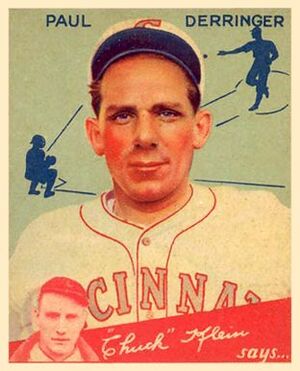Paul Derringer facts for kids
Quick facts for kids Paul Derringer |
|||
|---|---|---|---|
 |
|||
| Pitcher | |||
| Born: October 17, 1906 Springfield, Kentucky, U.S. |
|||
| Died: November 17, 1987 (aged 81) Sarasota, Florida, U.S. |
|||
|
|||
| debut | |||
| April 16, 1931, for the St. Louis Cardinals | |||
| Last appearance | |||
| September 27, 1945, for the Chicago Cubs | |||
| MLB statistics | |||
| Win–loss record | 223–212 | ||
| Earned run average | 3.46 | ||
| Strikeouts | 1,507 | ||
| Teams | |||
|
|||
| Career highlights and awards | |||
|
|||
Paul Derringer (born October 17, 1906 – died November 17, 1987) was an American baseball player. He was a right-handed pitcher in Major League Baseball (MLB). He played for three teams in the National League from 1931 to 1945. He is best known for his time with the Cincinnati Reds.
Paul Derringer was a very successful pitcher. He won 20 games in a season four times for the Reds. This happened between 1935 and 1940. His best year was 1939, when he won 25 games and lost only 7. That year, the Reds won the National League championship. His 161 wins with Cincinnati are a team record for a right-handed pitcher. He is also in the Cincinnati Reds Hall of Fame.
Starting His Baseball Journey
Derringer began his MLB career with the St. Louis Cardinals in 1931. He won 18 games that year. His team, the Cardinals, went on to win the 1931 World Series. He had an amazing streak of 33 innings where he didn't let the other team score any runs. This happened in September 1931.
Even though his team won the World Series, Derringer lost two games in that series. In 1932, his performance wasn't as strong. He won 11 games and lost 14. In 1933, he was traded to the Cincinnati Reds. That year was tough for him, as he lost 25 games for the Reds. This is still a team record for most losses in a season. However, he improved in 1934, winning 15 games.
His Best Seasons
In 1935, Derringer had a great year, winning 22 games and losing 13. He was chosen for the Major League Baseball All-Star Game for the first time. On May 24, 1935, he started the very first night game in major league history. He helped his team beat the Philadelphia Phillies 2–1. The lights for the stadium were turned on by President Franklin D. Roosevelt from the White House!
After a couple of average seasons, Derringer reached his peak from 1938 to 1940. In 1938, he won 21 games and led the league in innings pitched. He also completed many games, meaning he pitched the entire game himself.
His best season was in 1939. He won 25 games and had a great winning percentage. He was one of the top pitchers in the league for wins, strikeouts, and shutouts. He finished third in the voting for the league's Most Valuable Player (MVP) award. However, in the 1939 World Series against the New York Yankees, the Reds lost all four games. Derringer didn't get a win in that series.
In 1940, Derringer continued his strong play. He won 20 games and threw two games where he only allowed one hit. The Cincinnati Reds won the National League championship again. This time, in the 1940 World Series against the Detroit Tigers, Derringer helped his team win! After losing Game 1, he pitched two complete game wins in Games 4 and 7. The Reds won the World Series, their first championship since 1919.
Later Career and Legacy
After his peak years, Derringer's performance slowed down a bit. In 1941 and 1942, he was still good enough to be named an All-Star. In 1943, he was traded to the Chicago Cubs. He played for the Cubs until 1945. In his final season, 1945, he won 16 games. The Cubs also won the National League championship that year. He made a few appearances in the 1945 World Series against the Tigers.
Paul Derringer ended his career with 223 wins and 212 losses. He had 1,507 strikeouts and completed 251 games. In 1958, he was honored as a founding member of the Cincinnati Reds Hall of Fame. He passed away in Sarasota, Florida, at the age of 81.
See also
- List of Major League Baseball career wins leaders


